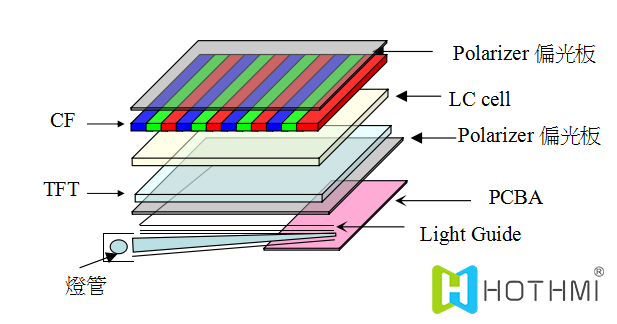

Here is the translation in English:
The common types of LCD displays include the following:
TN (Twisted Nematic): TN LCD screens are commonly used for segment displays. They are widely used in entry-level LCD panels due to their low production cost. TN screens have fast response times as the liquid crystal molecules rotate quickly. However, they have narrow viewing angles and can only display black and white monochrome or simple text and numbers. They are primarily used in consumer electronics such as digital watches and calculators.
HTN (High-Twisted Nematic): HTN LCD screens are high-twisted nematic displays. They use liquid crystal molecules sandwiched between two transparent glass layers, with the molecules twisted at an angle of 110 to 130 degrees. HTN screens offer high contrast, low power consumption, and low driving voltage compared to TN screens. They also provide wider viewing angles.
STN-LCD (Super Twisted Nematic): STN-LCD refers to super twisted nematic LCD displays. They work by placing the liquid crystal material between two transparent glass plates with perpendicular polarizers. STN LCDs use an electric field to change the arrangement of liquid crystal molecules, twisting them by more than 180 degrees to alter the optical rotation. STN screens consume less power and have the advantage of energy efficiency. They are commonly used for displaying text, numbers, and simple graphics in devices like low-end laptops, handheld computers, and stock tickers.
FSTN (Film-compensated Super Twisted Nematic): FSTN LCD screens were introduced to address the background color issue in STN displays. They include a compensation film in the polarizer to eliminate color dispersion and achieve black and white display.
TFT (Thin-Film Transistor): TFT-LCD displays are thin-film transistor LCD screens, also known as "true color" (TFT). TFT LCDs have a semiconductor switch for each pixel, allowing direct control through pulse signals. This enables independent and continuous control of each pixel, resulting in improved response times. TFT displays offer more accurate color control and are suitable for displaying animations and video. They are widely used in devices such as digital cameras, LCD projectors, and laptops.
These are the common types of LCD displays. TN screens are suitable for entry-level and consumer electronics, HTN screens offer wider viewing angles, STN-LCD is used for text and number displays, FSTN screens address background color issues, and TFT displays excel in fast response times and true color representation. The choice of LCD display depends on specific application requirements and budget considerations.

 Search
Search